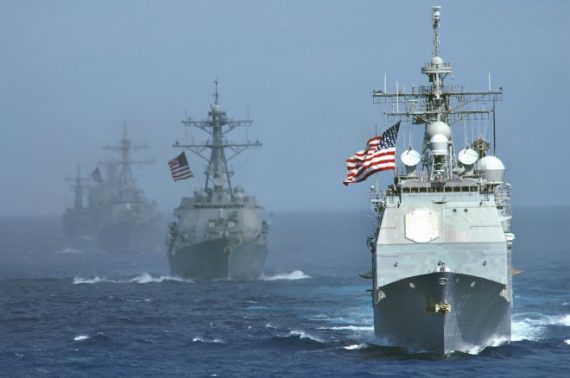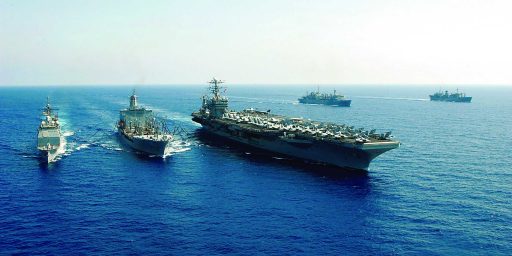Hollow Navy?
The United States has far and away the most capable navy on the planet. But it's not very capable at the moment.
The United States has far and away the most capable navy on the planet. But it’s not very capable at the moment.
Reuters (“U.S. Navy Deployments, Readiness Eroded By Budget Cuts: Navy Chief“):
Budget cuts have prompted the U.S. Navy to trim the number of warships deployed overseas and eroded the readiness of forces at home, undercutting its ability to respond rapidly to future crises around the globe, the top Navy officer said on Friday.
Admiral Jonathan Greenert, the chief of naval operations, said the Navy had an aircraft carrier strike group and an amphibious assault ship with U.S. Marines in the Arabian Sea. A similar group of ships is in the Western Pacific, he said.
In the event of a crisis, however, the Navy has only one fully prepared carrier strike group and one amphibious assault group in reserve that it could rush to the scene. By comparison, the Navy a year ago had three of each that could have been used.
“The rest of the fleet is not ready to deploy with all the capabilities that are needed that we would normally have in our fleet response plan,” Greenert told a Pentagon briefing.
The Navy has had to cut training and maintenance because of spending reductions to the point where many other ships and personnel are not fully certified for all the tasks they might ordinarily have to handle, he said.
Leaving aside that “one fully prepared carrier strike group and one amphibious assault group in reserve” is one more of each than any competitor, how can this possibly be? The Navy’s 2013 budget is $58.1 billion smaller than its 2012 budget. Still, $142.3 billion is no small chunk of change. Indeed, it’s more than all but two countries on the planet spend on their entire military budget. Indeed, it’s more than half again what Russia, the third ranking country, spends on defense.
So, what gives? Sequestration, of course. Although the total DoD-wide cut was only $37 billion, they were all crammed into the second half of the fiscal year. And pay and benefits for uniformed personnel, easily the biggest ticket item, was exempted from the cuts. That left the services with little flexibility to achieve short-run savings, especially since the law mandates that they be across-the-board.
Greenert said the Navy was working with the Pentagon and Congress to try to shift some of its funding between accounts so it could be used to offset training shortfalls. A similar move helped the Air Force resume flying some of its grounded planes.
He said the Navy still had 95 combat ships deployed abroad to support the Afghan war, conduct routine operations and respond to other crises. The total fleet is 286 ships.
The number of warships in the Pacific and Mediterranean has risen slightly because of the U.S. strategic shift to the Asia-Pacific and instability in the Middle East. The number of U.S. combat vessels has fallen slightly around Africa and the Indian Ocean. The Navy no longer has any combat ships in Latin America.
The Navy has as many ships as it had before sequestration. Indeed, it’s building more. But it can’t actually afford to use most of them, despite a massive budget, because Congress mandated cuts be made in the stupidest way possible.







Not just cuts, but also quid pro quo funding of the wrong programs to placate home constituencies.
Relax, Dr Joyner. President Rand Paul will fix it.
I wonder how glad the Navy is about buying it’s new and relatively worthless Littoral Combat Ships?
@Tony W: The funding part is stupid, but the cuts are actually a reflection of how the military itself tends to work… It strongly encourages colleagues to work out their differences between each other, because if you bring petty squabbles that grownups ought to be able to figure out to the CO or the First Shirt, they’re going to solve the problem the way they feels best, regardless of how much pain it puts _you_ through. In fact, your pain is a feature, not a bug. It will encourage you to solve your own damn problems next time.